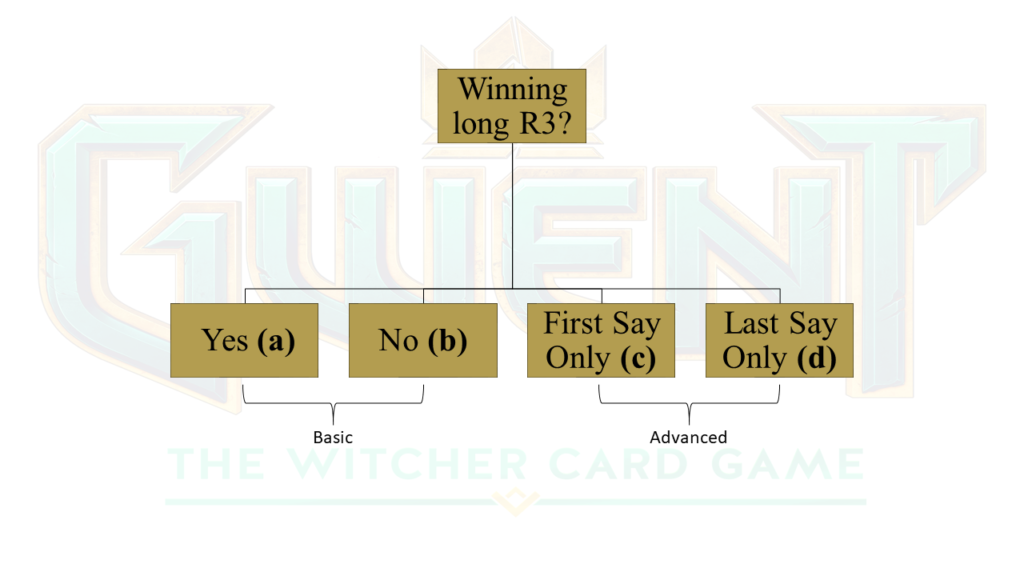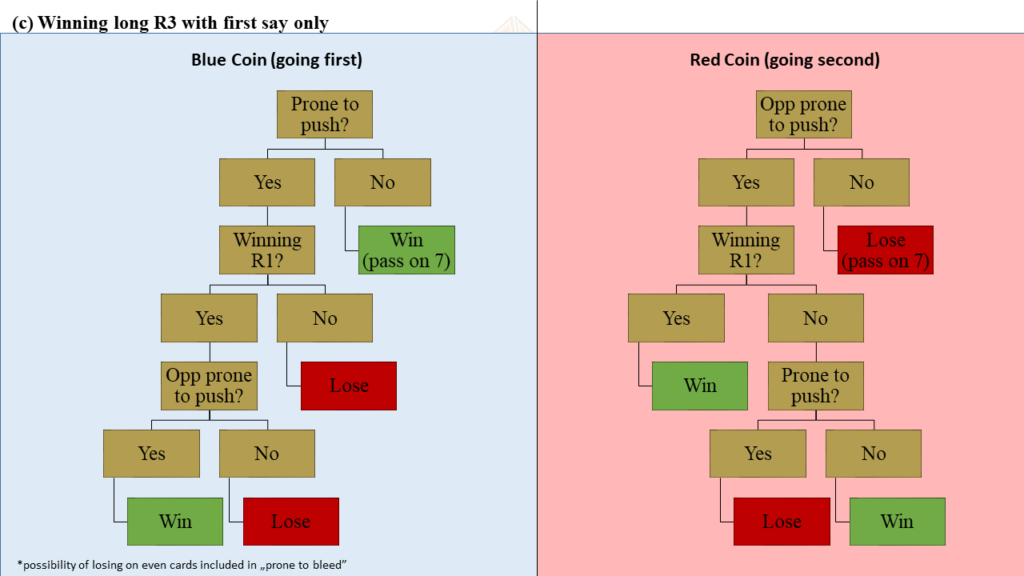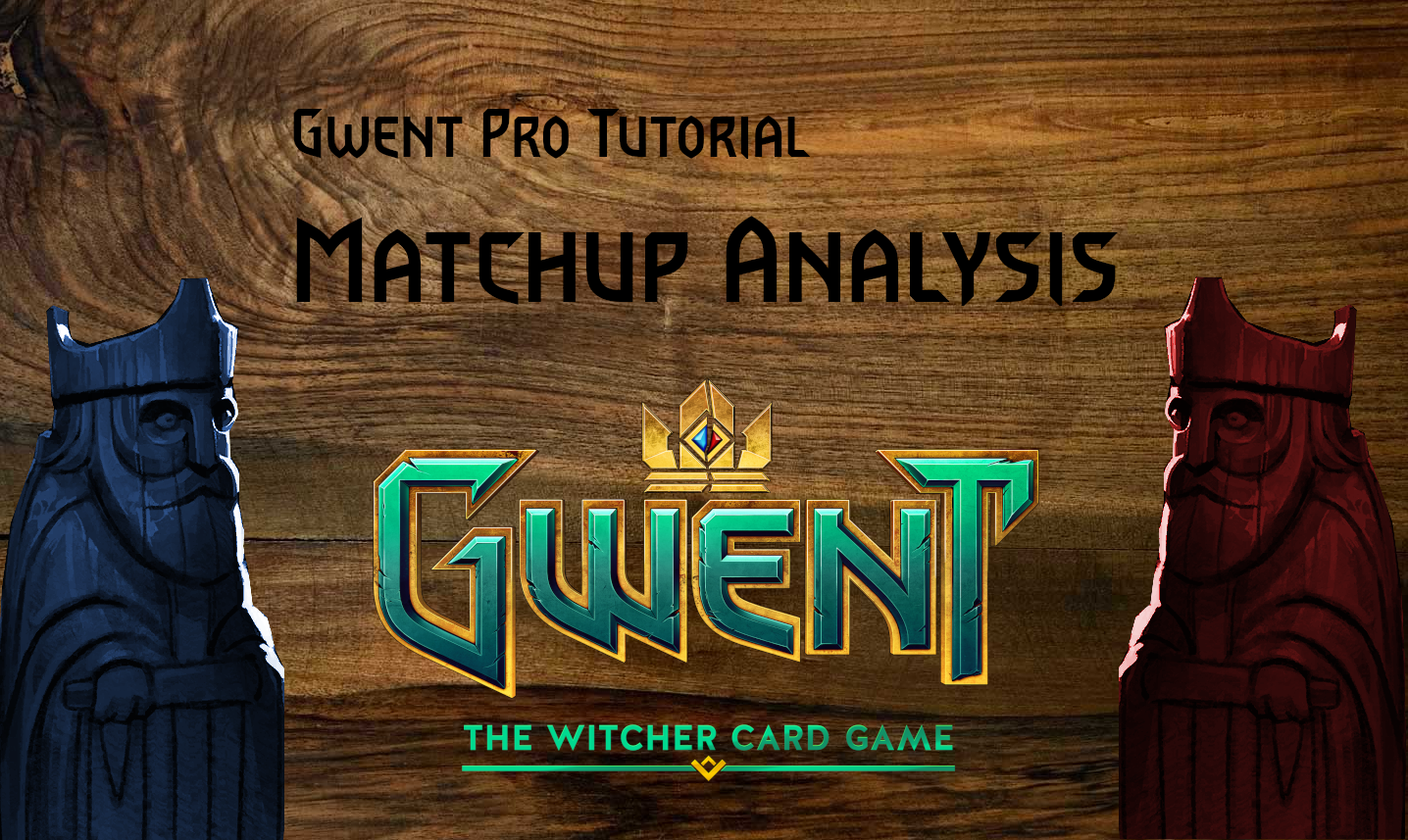Introduction
In this article we will approach the topic of matchups in Gwent: The Witcher Card game at a general level. The recognition of optimal gameplan depending on opponent’s deck is one of the most important skills in Gwent. While sometimes you would have to rely on intuition against unexpected decks, matchup knowledge gained by patient study of the temporary meta is even more important. Let’s learn which questions to ask when analyzing every single matchup.
Long round 3 - here we start!
A game of Gwent is distinguished by 3 rounds format. If both players refrain from active plays, then game naturally ends up in a long round 3.
The matchup analysis should begin from thorough analysis of 10 cards Round 3. What is the most optimal sequencing? Who is favoured? Is going first, or going second better and how much does it impact winning chances?

As could be seen in the scheme above, there are 4 main answers, leading to different scenarios, which will be analyzed in respective sections. Note that ‘Advanced’ part (c,d) is very common in mirror matches. When both sides play almost identical decks, long round outcome will come down exclusively to better position of first say/last say player.
Basic scenarios
(a) Long Round 3 is won

This scenario typically occurs in engines vs pointslam deck matchups. Opponent’s deck scales worse with round length and the order of play in R3 does not matter. Another example of this scenario is combo(payoff) vs pointslam, where the presence of long round finishers rather than engine openers leads to similar effect.
Opponent is oblied to win Round 1 and bleed in order to win, which most often would mean disadvantage.
The first thing to test in this scenario is if Round 1 could be won without wasting too much resources. If yes, then gg. If no, then you should aim at making opponent’s R2 push least harmful possible. Round length managment and optimizing resources in hand are main techniques.
Examples (Gwent 9.6):
Guerilla Tactics Traps vs Blood Scent Vampires – unable to find bleeding targets in a long round 3 against Traps, Vampires are unable to generate point value on own side of the board. At the same time, Traps deck gets full payoff value from Eldain and non-interactivity.
Salamandra Jackpot vs normal deck – powerful Salamandra long round payoff of poisoning whole board usually is enough to wipe out great deal of enemy units and win the game
(Gwent 10.10):
Lined Pockets Golden Nekker Self-poison vs Ursine Ritual Self-wound – with multiple answers to units going tall, as well as board control offered by Tunnel Drill, self-poison is strongly favored in a long round.
White Frost Devotion vs Reckless Flurry Sove – thanks to multiple, uneasy to remove engines, and optimal Frost value in a long round, White Frost Devotion is favored.
(b) Long Round 3 is lost

Just stepping into our opponent’s boots from (a). Proper bleeding (or defending the bleed) in R2 is perhaps the phase with highest skill expression. While counting opponent’s point reach is a matter of perfect tactical skills, strategy elements would still be useful. Defining win conditions for a short Round 3 and finding optimal lines in Round 2 could be done in advance to great extent.
(Gwent 10.10):
Reckless Flurry Sove Aerondight is unfavored in a long round in most matchups, but has strong tempo push with Sove and strong finisher combo with Sove + Aerondight in a short R3. Reckless Flurry would try to win R1 with minimal cost and bleed R2 with high tempo to get opponent’s long round 3 win conditions out.
Advanced Scenarios
(c) First say R3 wins

The decision tree for this particular scenario is the most complex one, because only one player could voluntarily lose Round 1 first without losing on even cards. It is Blue Coin player.
Red Coin tree is basically a mirror image of Blue Coin one with roles reversed. It could be generally expected that Blue Coin player would be favored, as Red is forced to bleed in case of pass at 7.
A common theme in such matchups is R2 length management from both sides. Being better in long R3 with first say usually means also being in very good position when pushing long R2. The shorter R2, the smaller order advantage would usually be, and seizing perfect moment for a pass is crucial.
(Gwent 10.10):
This scenario is characteristic for mirrors of damaging engines decks (Siege mirrors are very clear cut here) or more generally, whenever setting up the board as first is preferable (think of Rebukes in Devotion Gift mirrors)
(d) Last say R3 wins

… as simple as that. Just win R1. Every time a matchup of this type arises, you should get ready to rumble in R1. Make sure to mulligan out unplayable cards in R1 if only not absolute win cons and prepare for a hard fight.
This scenario very often arises in a duel of two control decks. Player going second in Round 3 gets an uninteractive last say and often forces oppponent to sequence suboptimally.
(Gwent 10.10)
Imprisonment Renfri Yrden mirrors – having the last say enables playing Triss:Meteor Shower and Geralt:Yrden for optimal value.
Guerilla Tactics Control mirrors – going first is troublesome in a deck lacking proactive plays. The player with last say could make use of Harald Gord finisher.
Takeouts
- Matchups knowledge is crucial for Gwent performance and should be acquired systematically. Always start from long round 3!
- There are common patterns in Gwent matchups, typical cases which repeats on and on. These should be recognized to build up strategic intuition.
- If preparing for an important tourney or trying to improve ladder gameplay fast, find a partner for matchup studies.
Thanks for reading and see you in Gwent!

